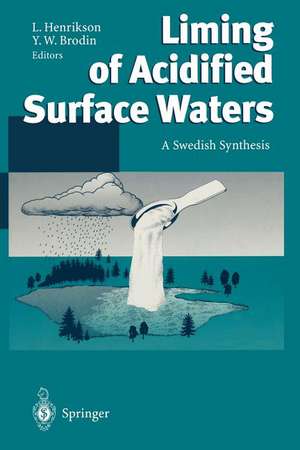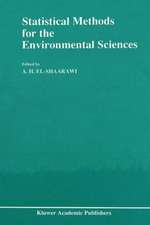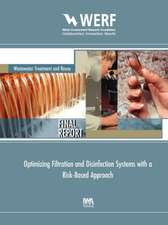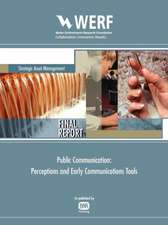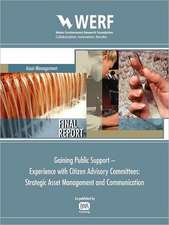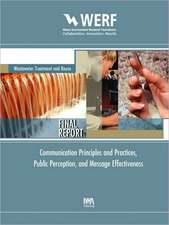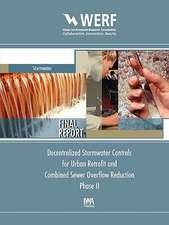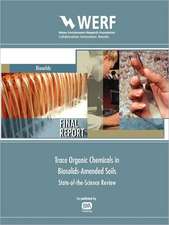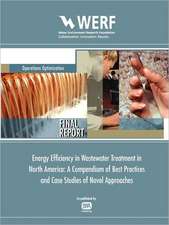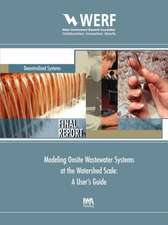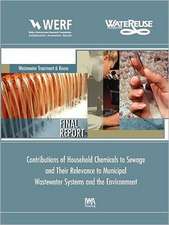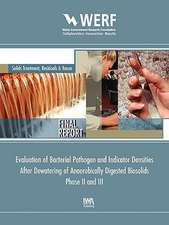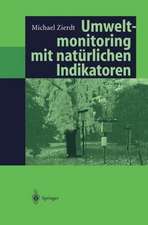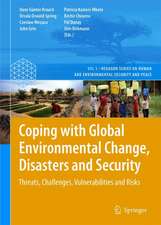Liming of Acidified Surface Waters: A Swedish Synthesis
Editat de Lennart Henrikson, Y. W. Brodinen Limba Engleză Paperback – 22 noi 2011
Preț: 398.92 lei
Nou
Puncte Express: 598
Preț estimativ în valută:
76.34€ • 82.90$ • 64.13£
76.34€ • 82.90$ • 64.13£
Carte tipărită la comandă
Livrare economică 22 aprilie-06 mai
Preluare comenzi: 021 569.72.76
Specificații
ISBN-13: 9783642793110
ISBN-10: 3642793118
Pagini: 484
Ilustrații: XIX, 458 p.
Dimensiuni: 155 x 235 x 25 mm
Greutate: 0.67 kg
Ediția:Softcover reprint of the original 1st ed. 1995
Editura: Springer Berlin, Heidelberg
Colecția Springer
Locul publicării:Berlin, Heidelberg, Germany
ISBN-10: 3642793118
Pagini: 484
Ilustrații: XIX, 458 p.
Dimensiuni: 155 x 235 x 25 mm
Greutate: 0.67 kg
Ediția:Softcover reprint of the original 1st ed. 1995
Editura: Springer Berlin, Heidelberg
Colecția Springer
Locul publicării:Berlin, Heidelberg, Germany
Public țintă
ResearchCuprins
1 Liming of surface waters in Sweden — a synthesis.- Summary.- 1. Introduction.- 1.1. From trial programme to large-scale liming.- 1.2. Previous documentation of liming activities in Sweden.- 1.3. The aims of the synthesis and the target group.- 1.4. Liming practices in other countries.- 2. Acidification loss of biological diversity and fish catch.- 3. Liming — a part of the Swedish strategy to counteract acidificatioation.- 3.1. Strategy.- 3.2. For how long is liming necessary?.- 3.3. Alternatives and complementary strategies.- 4. Aims and accomplishment.- 4.1. Aims.- 4.2. Extent and accomplishment.- 4.3. Strategies, methods and liming agents.- 5. The effects of liming.- 5.1. Desirable and undesirable effects.- 5.2. Water quality.- 5.3. Biology.- 5.4. Mercury in fish.- 5.5. Socio-economic consequences.- 6. Will liming restore ecosystems?.- 7. Complementary measures.- 8. Lack of knowledge and research needed.- 8.1. Ecological and socio-economic effects.- 8.2. Strategy and methodology.- 9. Conclusions.- 9.1. Overall conclusions.- 9.2. Recommendations for liming of lakes and water-courses.- 9.3. Concluding remarks.- 10. Acknowledgements.- 11. References.- 2 Acidification of lakes and watercourses in a global perspective.- Summary.- 1. Acidification: a complex problem.- 2. Acidification in the aquatic environment.- 3. Causes of acidification.- 4. How much can the environment withstand?.- 5. Outlook and future action.- 6. References.- 3 Acidification of Swedish freshwaters.- Summary 53.- 1. Introduction.- 2. Acidifying load.- 3. The extent of acidification.- 4. Biological impact.- 4.1. Biodiversity.- 4.2. Causes of changes in flora and fauna.- 4.3. Decomposition.- 4.4. Human health.- 5. Necessary action and research.- 6. References.- 4 Strategies and methods forfreshwater liming.- Summary.- 1. Introduction.- 2. History.- 3. The accumulated liming requirements for soil and water.- 4. Purpose and aims.- 5. Criteria for state grants.- 6. Liming organization.- 6.1. Liming plans and application.- 6.2. Monitoring of effects.- 6.3. Staff.- 6.4. Changes in the liming grant.- 6.5. Extent of liming.- 7. Liming strategies and methods.- 7.1. Strategies.- 7.2. Methods.- 7.2.1 Lake liming.- 7.2.2 Wetland liming.- 7.2.3. Solid ground liming.- 7.2.4. Doser liming.- 7.2.5. Stream liming.- 7.2.6. Ditch liming.- 7.2.7. Road liming.- 7.2.8. Lime precipitation in wastewater treatment plants.- 8. Liming agents and fractions.- 8.1. Agents.- 8.2. Fractions of limestone and dolomite.- 8.3. Quality control of lake lime.- 9. Doses of lime and other neutralizing agents.- 9.1. Lime dissolution rates.- 9.2. Dosage recommendations.- 10. Cost.- 11. Complementary methods.- 12. References.- 5 The effects of liming on water chemistry.- Summar.- 1. Introductio.- 1.1. Materia.- 2. Primary effects of liming.- 2.1. Primary water chemistry reactions.- 2.2. Acidic episodes.- 2.3. Lake liming.- 2.3.1. Whole-lake liming.- 2.3.2. Littoral liming.- 2.3.3. Soda.- 2.4. Liming of watercourses.- 2.5. Catchment liming.- 3. Secondary physical-chemical effects.- 3.1. Physical effects.- 3.2. Effects on water chemistry.- 3.2.1. Organic substances and optical characteristics.- 3.2.2. Phosphorus compounds.- 3.2.3. Nitrogen compounds.- 3.2.4. Trace metals.- 3.2.5. Aluminium.- 3.2.6. Iron and manganese.- 3.2.7. Other trace metals.- 3.3. Changes in sediment chemistr.- 4. Effects of liming in entire aquatic systems.- 4.1. River Fylleån.- 4.2. River Enningdalsälven.- 5. Effects of liming activities on water chemistry.- 5.1. Comparisons between limed and non-limed waters.- 5.2.Comparison with results from model calculations.- 6. Acknowledgements.- 7. References.- 6 The effects of liming on microbial activity and the decomposition of organic material.- Summary.- 1. Introduction.- 2. Bacterial density and microbial biomass.- 3. Microbial activity.- 3.1. Microbial activity in the water.- 3.2. Microbial activity in the sediment.- 4. Decomposition of coarse detritus.- 5. References.- 7 The effects of liming on aquatic flora.- Summary.- 1. The conditions for flora in acidified and limed lakes.- 1.1. Acidification.- 1.2. Liming.- 2.Phytoplankton.- 2.1. Impact of acidification.- 2.2. Number of species and composition of species after liming.- 2.2.1. Clear-water lakes.- 2.2.2. Humic lakes.- 2.3. Biomass and primary production after liming.- 3. Epiphytic algae.- 3.1. Impact of acidification.- 3.2. Number and composition of species.- 3.3. Biomass and abundance.- 4. Macrophytes.- 4.1. Impact of acidification.- 4.2. Number and composition of species.- 4.3. Abundance and primary production.- 5. Wetland vegetation.- 5.1. Impact of acidification.- 5.2. Number and composition of species.- 5.3. Biomass and density.- 5.4. Potential long-term effects.- 6. References.- 8 The effects of liming on aquatic fauna.- Summary.- 1. Introduction.- 2. Lakes.- 2.1. Fish and crayfish.- 2.1.1. Background — the impact of acidification.- 2.1.2. Number of species.- 2.1.3. Recruitment and number of individuals.- 2.1.4. The structure of fish communities.- 2.2. Zooplankton.- 2.2.1. Background — the impact of acidification.- 2.2.2. Species composition and diversity.- 2.2.3. The structure of the zooplankton community.- 2.3. Benthic fauna and pelagic insects.- 2.3.1. Background — the impact of acidification.- 2.3.2. Composition of species and number of species.- 2.3.3.Abundance.- 2.4. Birds.- 2.4.1. Background — the impact of acidification.- 2.4.2. The effects of liming.- 2.5. Frogs.- 2.5.1. Background — the impact of acidification.- 2.5.2. The effects of liming.- 3. Running waters.- 3.1. Fish.- 3.1.1. Background — the impact of acidification.- 3.1.2. Number of species.- 3.1.3. Recruitment and number of individuals.- 3.1.4. Growth and production of individuals.- 3.1.5. The structure of fish communities.- 3.2. Benthic fauna.- 3.2.1. Background — the impact of acidification.- 3.2.2. Number of species and density.- 3.2.3. Functional groups.- 4. Can the original fauna be restored after liming?.- 5. Factors affecting the post-liming development of fauna.- 5.1. Water chemistry.- 5.2. Liming strategies.- 5.3. Recolonization.- 6. References.- 9 The impact of liming on aquatic communities.- Summary.- 1. Introduction.- 2. Communities of organisms.- 3. Short-term and long-term effects of liming.- 4. Post-liming abiotic factors.- 5. Acidification and community development.- 6. Productivity and community structure.- 7. Biotic factors: competition as a controlling factor.- 8. “Bottom-up” effects.- 9. “Top-down” effects.- 10. Predation and changeable environments.- 11. Parasites and disease: an unknown factor?.- 12. Stability of post-liming communities.- 13. Trophic levels and food chains.- 14. Can acidified communities be restored?.- 15. Acknowledgements.- 16. References.- 10 Liming strategies and effects: the Lake Gårdsjön case study.- 1. Documentation.- 2. Geographical orientation.- 3. Acidification status.- 3.1. Interactions in the pelagic zone.- 4. Liming strategy and re-introduction of fish.- 5. The effects of liming.- 5.1. Water chemistry.- 5.2. Pelagic organisms.- 5.2.1. Post-liming interactions in the pelagic zone.-5.2.5. Interactions in the pelagic zone after re-introduction of fish.- 6. Conclusions.- 7. References.- 11 Liming strategies and effects: the Lake Västra Skälsjön case study.- 1. Documentation.- 2. Geographical orientation.- 3. Acidification status.- 4. Liming strategy.- 5. Effects of liming.- 5.1. Water chemistry.- 5.2. Flora.- 5.3. Zooplankton and benthic fauna.- 5.4. Fish.- 6. Conclusions.- 7. References.- 12 Liming strategies and effects: the Lake Stora Härsjön case study.- 1. Documentation.- 2. Geographical orientation.- 3. Acidification status.- 4. Liming strategy.- 5. The effects of liming.- 5.1. Phytoplankton.- 5.2. Zooplankton.- 5.3. Benthic fauna.- 5.4. Fish.- 5.5. Comparison of different trophic levels.- 6. Conclusions.- 7. References.- 13 Liming strategies and effects: the Lake Gyslättasjön case study.- 1. Documentation.- 2. Geographical orientation.- 3. Acidification status.- 4. Liming strategy.- 5. Effects of liming.- 5.1. Water chemistry.- 5.2. Phytoplankton.- 5.3. Zooplankton.- 5.4. The littoral benthic fauna.- 5.5. Fish.- 6. Conclusions.- 7. References.- 14 Liming strategies and effects: the River Högvadsån case study.- 1. Documentation.- 2. Geographical orientation.- 3. Acidification status.- 4. Liming strategy.- 5. Effects of liming.- 5.1. Water chemistry.- 5.2. Salmon stock.- 6. Conclusions.- 7. References.- 15 Liming strategies and effects: the Prästvallsbäcken Stream case study.- 1. Documentation.- 2. Geographical orientation.- 3. Acidification status.- 4. Liming strategy.- 5. Effects of liming.- 6. Conclusions.- 7. References.- 16 Liming effects on mercury concentrations in fish.- Summary.- 1. Introduction.- 2. Methods.- 2.1. Study lakes.- 2.2. Treatments.- 2.3. Sampling and analyses.- 2.4. Calculations.- 3. Results and discussion.-3.1. Pre-treatment situation.- 3.2. Liming.- 3.3. Development of Hg concentrations in pike after liming.- 3.4. Potential mechanisms.- 3.5. Cost-benefit analysis.- 4. Conclusions.- 5. Acknowledgements.- 6. References.- 17 Supplementary measures to aquatic liming.- Summary.- 1. Introduction.- 2. Measures to promote colonization and re-establish locally extinct species.- 2.1. Habitat improvement.- 2.2. Removal of migration obstacles and building of fish-ways.- 2.3. Restocking existing populations.- 2.4. Decimation fishing.- 2.5. Other measures.- 3. Reintroduction of locally extinct species.- 3.1. Salmonid fish (Atlantic salmon, trout, grayling and Arctic char).- 3.2. Other species of fish.- 3.3. Crayfish and other invertebrates.- 4. Conclusions.- 5. References.- 18 Socio-economic consequences of aquatic liming.- Summary.- 1. Introduction.- 2. Methods.- 3. Examples of the value of recreational salmon fishing, the impact of acid rain and the benefit of liming.- 3.1. Canada.- 3.2. Scotland.- 3.3. England.- 3.4. Iceland.- 3.5. Norway.- 3.6. Sweden.- 4. Cost-benefit studies of liming.- 4.1. The pre-liming recreational value of salmon and trout fishing in a Norwegian river.- 4.2. The socio-economic value of liming in Audna.- 5. Liming, commercial fishing, fish farming and aquaculture.- 5.1. Commercial fishing.- 5.2. Fish farming and aquaculture.- 6. The effects of liming on recreational fishing, leisure and tourism.- 6.1. Recreational fishing and liming in Sweden.- 6.1.1. Forest Service fishing projects.- 6.1.2. The Älvkarleby study.- 6.1.3. The Blekinge County Council study.- 6.1.4. The River Mörrumsån study.- 6.1.5. The West Coast study.- 7. Examples of the value of liming to recreational fishing.- 7.1. Introduction.- 7.2. Results and discussion.- 7.2.1. RiverHögvadsån.- 7.2.2. River Mörrumsån.- 7.2.3. Lake Lilla Le.- 7.2.4. Lake Unden.- 7.2.5. Fulufjället.- 7.2.6. Lake Bolmen.- 7.2.7. Hökensås.- 7.2.8. The Delsjö area.- 7.2.9. Lake Rottnen.- 8. Liming and mercury.- 9. Liming and caesium.- 10. Liming and environmental commitment.- 11. Acknowledgements.- 12. References.
Recenzii
"I found the book very informative and the style easy to read. There is a large bibliography accompanying each chapter and the wealth of practical data should make it a useful reference work for those interested or involved in the liming of lakes or streams." Environmental Pollution
